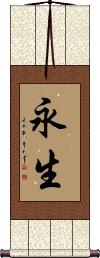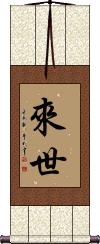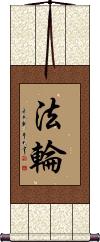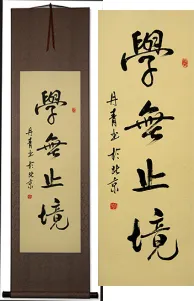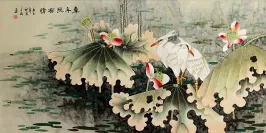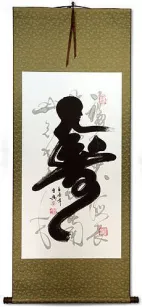Many custom options...
And formats...

Eternal Life in Chinese / Japanese...
Buy an Eternal Life calligraphy wall scroll here!
Personalize your custom “Eternal Life” project by clicking the button next to your favorite “Eternal Life” title below...
Eternal Life / Everlasting Life / Immortality
永生 are the last two words from John 3:16 in the Chinese Union Bible.
Although not specifically Christian, this is the way to express ever-lasting life or eternal life in Chinese.
In Japanese, this can either mean eternal life or immortality.
See Also: Eternity | Rebirth | Reincarnation | Immortality
Eternal Life / Future Life
來世 is a word that can be used in many different ways.
It is often used to express the next life (life in heaven or wherever your soul is bound for). So it does have a religious overtone. However, it can also be used to express your life in the future - perhaps during your present lifetime.
It can also be translated as “the next world,” “the next generation,” “the time that is to come,” “otherworld,” or simply “posterity.”
See Also: Eternity | Rebirth | Reincarnation | Immortality
Eternal Wheel of Life
法輪 is the Chinese, Japanese Kanji, and old Korean Hanja title, “The Eternal Wheel of Life,” in Buddhism.
Also known as the wheel of the law, or Buddha-truth, which can crush all evil and all opposition. It is likened to Indra's wheel, which rolls on from man-to-man, place-to-place, age-to-age.
Colloquially used in some sects to mean preaching or spreading Buddha-truth.
Forever Young / Long Life
This in-stock artwork might be what you are looking for, and ships right away...
Gallery Price: $61.00
Your Price: $33.88
Gallery Price: $200.00
Your Price: $122.88
Gallery Price: $180.00
Your Price: $99.88
Gallery Price: $100.00
Your Price: $49.88
Gallery Price: $100.00
Your Price: $58.88
Gallery Price: $100.00
Your Price: $58.88
Gallery Price: $340.00
Your Price: $188.88
Gallery Price: $61.00
Your Price: $33.88
Gallery Price: $61.00
Your Price: $33.88
Gallery Price: $61.00
Your Price: $33.88
Longevity / Long Life Unique Calligraphy Scroll
Discounted Blemished
Gallery Price: $47.00
Your Price: $26.00
Gallery Price: $61.00
Your Price: $33.88
Not the results for eternal life that you were looking for?
Below are some entries from our dictionary that may match your eternal life search...
| Characters If shown, 2nd row is Simp. Chinese |
Pronunciation Romanization |
Simple Dictionary Definition |
佛 see styles |
fú fu2 fu hotoke ほとけ |
More info & calligraphy: Buddhism / Buddha(surname) Hotoke Buddha, from budh to "be aware of", "conceive", "observe", "wake"; also 佛陀; 浮圖; 浮陀; 浮頭; 浮塔; 勃陀; 勃馱; 沒馱; 母馱; 母陀; 部陀; 休屠. Buddha means "completely conscious, enlightened", and came to mean the enlightener. he Chinese translation is 覺 to perceive, aware, awake; and 智 gnosis, knowledge. There is an Eternal Buddha, see e.g. the Lotus Sutra, cap. 16, and multitudes of Buddhas, but the personality of a Supreme Buddha, an Ādi-Buddha, is not defined. Buddha is in and through all things, and some schools are definitely Pan-Buddhist in the pantheistic sense. In the triratna 三寳 commonly known as 三寳佛, while Śākyamuni Buddha is the first "person" of the Trinity, his Law the second, and the Order the third, all three by some are accounted as manifestations of the All-Buddha. As Śākyamuni, the title indicates him as the last of the line of Buddhas who have appeared in this world, Maitreya is to be the next. As such he is the one who has achieved enlightenment, having discovered the essential evil of existence (some say mundane existence, others all existence), and the way of deliverance from the constant round of reincarnations; this way is through the moral life into nirvana, by means of self-abnegation, the monastic life, and meditation. By this method a Buddha, or enlightened one, himself obtains Supreme Enlightenment, or Omniscience, and according to Māhāyanism leads all beings into the same enlightenment. He sees things not as they seem in their phenomenal but in their noumenal aspects, as they really are. The term is also applied to those who understand the chain of causality (twelve nidānas) and have attained enlightenment surpassing that of the arhat. Four types of the Buddha are referred to: (1) 三藏佛the Buddha of the Tripiṭaka who attained enlightenment on the bare ground under the bodhi-tree; (2) 通佛the Buddha on the deva robe under the bodhi-tree of the seven precious things; (3) 別佛the Buddha on the great precious Lotus throne under the Lotus realm bodhi-tree; and (4) 圓佛the Buddha on the throne of Space in the realm of eternal rest and glory where he is Vairocana. The Hīnayāna only admits the existence of one Buddha at a time; Mahāyāna claims the existence of many Buddhas at one and the same time, as many Buddhas as there are Buddha-universes, which are infinite in number. |
身 see styles |
shēn shen1 shen misaki みさき |
More info & calligraphy: Body(1) one's body; one's person; (2) oneself; one's appearance; (3) one's place (in society, etc.); one's position; (4) main part; meat (as opposed to bone, skin, etc.); wood (as opposed to bark); blade (as opposed to its handle); container (as opposed to its lid); (surname) Misaki kāya; tanu; deha. The body; the self.; Two forms of body; there are numerous pairs, e. g. (1) (a) 分段身 The varied forms of the karmic or ordinary mortal body, or being; (b) 變易身 the transformable, or spiritual body. (2) (a) 生身 The earthly body of the Buddha; (b) 化身 hinirmāṇakāya, which may take any form at will. (3) (a) 生身 his earthly body; (b) 法身 his moral and mental nature—a Hīnayāna definition, but Mahāyāna takes his earthly nirmāṇakāya as the 生身 and his dharmakāya or that and his saṃbhogakāya as 法身. (4) 眞應二身 The dharmakāya and nirmāṇakāya. (5) (a) 實相身 The absolute truth, or light, of the Buddha, i. e. the dharmakāya; (b) 爲物身 the functioning or temporal body. (6) (a) 眞身 the dharmakāya and saṃbhogakāya; (b) 化身 the nirmāṇakāya. (7) (a) 常身 his permanent or eternal body; (b) 無常身 his temporal body. (8) (a) 實身 and 化身 idem 二色身. |
永生 see styles |
yǒng shēng yong3 sheng1 yung sheng hisaki ひさき |
More info & calligraphy: Eternal Life / Everlasting Life / Immortalityeternal life; immortality; (personal name) Hisaki Eternal life; immortality; nirvana is defined as 不生 not being born, i. e. not reborn, and therefore 不滅 not dying; 永生 is also perpetual life; the Amitābha cult says in the Pure Land. |
法輪 法轮 see styles |
fǎ lún fa3 lun2 fa lun noriwa のりわ |
More info & calligraphy: Eternal Wheel of Life{Buddh} (See 輪宝,転法輪) the teachings of Buddha (as likened to the Dharmachakra, originally a wheel-like weapon used to destroy the evils of mankind); Buddhist doctrine; (surname) Noriwa dharmacakra, the Wheel of the Law, Buddha-truth which is able to crush all evil and all opposition, like Indra's wheel, and which rolls on from man to man, place to place, age to age. 轉法輪To turn, or roll along the Law-wheel, i.e. to preach Buddha-truth. |
万才 see styles |
manzai まんざい |
(out-dated kanji) two-person comedy act (usu. presented as a fast-paced dialogue, occ. presented as a skit); comic dialogue; (int,n) (1) crying "banzai" (or raising one's hands in the banzai gesture); (2) something worthy of celebration; (3) (archaism) long time; (4) (archaism) eternal life (and prosperity); (interjection) (5) banzai (a celebratory cheer); hurrah (hooray, hurray); (int,n) (1) crying "banzai" (or raising one's hands in the banzai gesture); (2) something worthy of celebration; (3) giving up; (4) (archaism) long time; (5) (archaism) eternal life (and prosperity); (interjection) (6) banzai (a celebratory cheer); hurrah (hooray, hurray); (place-name, surname) Manzai |
万歳 see styles |
manzai まんざい |
door-to-door comedic duo; (int,n) (1) crying "banzai" (or raising one's hands in the banzai gesture); (2) something worthy of celebration; (3) (archaism) long time; (4) (archaism) eternal life (and prosperity); (interjection) (5) banzai (a celebratory cheer); hurrah (hooray, hurray); (int,n) (1) crying "banzai" (or raising one's hands in the banzai gesture); (2) something worthy of celebration; (3) giving up; (4) (archaism) long time; (5) (archaism) eternal life (and prosperity); (interjection) (6) banzai (a celebratory cheer); hurrah (hooray, hurray); (surname) Manzai |
不死 see styles |
bù sǐ bu4 si3 pu ssu fushi ふし |
(noun - becomes adjective with の) (1) immortality; eternal life; (noun - becomes adjective with の) (2) (usu. in RPGs, etc.) undeath; undead Undying, immortal. |
五時 五时 see styles |
wǔ shí wu3 shi2 wu shih goji |
(五時教) The five periods or divisions of Śākyamuni's teaching. According to Tiantai they are (1) 華嚴時 the Avataṃsaka or first period in three divisions each of seven days, after his enlightenment, when he preached the content, of this sutra; (2) 鹿苑時 the twelve years of his preaching the Āgamas 阿含 in the Deer Park; (3) 方等時 the eight years of preaching Mahāyāna-cum-Hīnayāna doctrines, the vaipulya period; (4) 般若時 the twenty-two years of his preaching the prajñā or wisdom sutras; (5) 法華涅槃時 the eight years of his preaching the Lotus Sutra and, in a day and a night, the Nirvana Sutra. According to the Nirvana School (now part of the Tiantai) they are (1) 三乘別教 the period when the differentiated teaching began and the distinction of the three vehicles, as represented by the 四諦 Four Noble Truths for śrāvakas, the 十二因緣 Twelve Nidānas for pratyekabuddhas, and the 六度 Six Pāramitās for bodhisattvas; (2) 三乘通教 the teaching common to all three vehicles, as seen in the 般若經; (3) 抑揚教 the teaching of the 維摩經, the 思益梵天所問經, and other sutras olling the bodhisattva teaching at the expense of that for śrāvakas; (4) 同歸教 the common objective teaching calling all three vehicles, through the Lotus, to union in the one vehicle; (5) 常住教 the teaehmg of eternal life i. e. the revelation through the Nirvana sutra of the eternity of Buddhahood; these five are also called 有相; 無相; 抑揚; 曾三歸—; and 圓常. According to 劉虬 Liu Chiu of the 晉 Chin dynasty, the teaching is divided into 頓 immediate and 漸 gradual attainment, the latter having five divisions called 五時教 similar to those of the Tiantai group. According to 法寶 Fabao of the Tang dynasty the five are (1) 小乘; (2) 般着 or 大乘; (3) 深密 or 三乘; (4) 法華 or 一乘; (5) 涅槃 or 佛性教. |
佛壽 佛寿 see styles |
fó shòu fo2 shou4 fo shou butsu ju |
Buddha's life, or age. While he only lived to eighty as a man, in his saṁbhogakāya he is without end, eternal; cf. Lotus Sutra, 壽量品, where Buddha is declared to be eternal. |
十妙 see styles |
shí miào shi2 miao4 shih miao jūmyō |
The ten wonders, or incomprehensibles; there are two groups, the 迹v traceable or manifested and 本門妙 the fundamental. The 迹門十妙 are the wonder of: (1) 境妙 the universe, sphere, or whole, embracing mind, Buddha, and all things as a unity; (2) 智妙 a Buddha's all-embracing knowledge arising from such universe; (3) 行妙 his deeds, expressive of his wisdom; (4) 位妙 his attainment of all the various Buddha stages, i.e. 十住 and十地; (5) 三法妙 his three laws of 理, 慧, and truth, wisdom, and vision; (6) 感應妙 his response to appeal, i.e. his (spiritual) response or relation to humanity, for "all beings are my children"; (7) 神通妙 his supernatural powers; (8) 說法妙 his preaching; (9) 眷屬妙 his supernatural retinue; (10) 利益妙 the blessings derived through universal elevation into Buddhahood. The 本門十妙 are the wonder of (1) 本因妙 the initial impulse or causative stage of Buddhahood; (2) 本果妙 its fruit or result in eternity, joy, and purity; (3) 國土妙 his (Buddha) realm; (4) 感應妙 his response (to human needs); (5) 神通妙 his supernatural powers; (6) 說法妙 his preaching; (7) 眷屬妙 his supernatural retinue; (8) 涅槃妙 his nirvāṇa; (9) 壽命妙 his (eternal) life; (10) his blessings as above. Both groups are further defined as progressive stages in a Buddha's career. These "wonders" are derived from the Lotus sūtra. |
投淵 投渊 see styles |
tóu yuān tou2 yuan1 t`ou yüan tou yüan tōen |
To cast oneself into an abyss (hoping for eternal life). |
斷見 断见 see styles |
duàn jiàn duan4 jian4 tuan chien danken |
ucchedadarśana; the view that death ends life, in contrast with 常見 that body and soul are eternal—both views being heterodox; also world-extinction and the end of causation. |
涅槃 see styles |
niè pán nie4 pan2 nieh p`an nieh pan nehan ねはん |
(Buddhism) to achieve nirvana (extinction of desire and pain); to die (loanword from Sanskrit, abbr. for 涅槃那[nie4 pan2 na4]) (1) {Buddh} nirvana; supreme enlightenment; (2) {Buddh} death; death of Buddha nirvāṇa, 'blown out, gone out, put out, extinguished'; 'liberated-from existence'; 'dead, deceased, defunct.' 'Liberation, eternal bliss'; '(with Buddhists and Jainas) absolute extinction or annihilation, complete extinction of individual existence.' M.W. Other forms are 涅槃那; 泥日; 泥洹; 泥畔 Originally translated 滅 to extinguish, extinction, put out (as a lamp or fire), it was also described as 解脫 release, 寂滅 tranquil extinction; 無爲 inaction, without effort, passiveness; 不生 no (re)birth; 安樂 calm joy; 滅度transmigration to 'extinction'. The meaning given to 'extinction' varies, e.g. individual extinction; cessation of rebirth; annihilation of passion; extinction of all misery and entry into bliss. While the meaning of individual extinction is not without advocates, the general acceptation is the extinction or end of all return to reincarnation with its concomitant suffering, and the entry into bliss. Nirvāṇa may be enjoyed in the present life as an attainable state, with entry into parinirvāṇa, or perfect bliss to follow. It may be (a) with a 'remainder', i.e. the cause but not all the effect (karma), of reincarnation having been destroyed; (b) without 'remainder', both cause and effect having been extinguished. The answer of the Buddha as to the continued personal existence of the Tathāgata in nirvāṇa is, in the Hīnayāna canon, relegated 'to the sphere of the indeterminates' (Keith), as one of the questions which are not essential to salvation. One argument is that flame when blown out does not perish but returns to the totality of Fire. The Nirvāṇa Sutra claims for nirvāṇa the ancient ideas of 常樂我淨 permanence, bliss, personality purity in the transcendental realm. Mahāyāna declares that Hīnayāna by denying personality in the transcendental realm denies the existence of the Buddha. In Mahāyāna final nirvāṇa is transcendental, and is also used as a term for the absolute. The place where the Buddha entered his earthly nirvāṇa is given as Kuśinagara, cf. 拘. |
長生 长生 see styles |
cháng shēng chang2 sheng1 ch`ang sheng chang sheng yoshio よしお |
long life (n,vs,vi) (1) longevity; (2) {go} eternal life; cycle that can be repeated indefinitely and neither group dies; (given name) Yoshio Long or eternal life (in Paradise), 長生不死, 長生不老 long life without death, or growing old, immortality. |
顯本 显本 see styles |
xiǎn běn xian3 ben3 hsien pen |
The revelation of his fundamental or eternal life by the Buddha in the Lotus Sūtra. |
三無性 三无性 see styles |
sān wú xìng san1 wu2 xing4 san wu hsing san mushō |
The three things without a nature or separate existence of their own: (a) 相無性 form, appearance or seeming, is unreal, e.g. a rope appearing like a snake; (b) 生無性 life ditto, for it is like the rope, which is derived from constituent materials; (c) 勝義無性 the 勝義, concept of the 眞如 or bhūtatathatā, is unreal, e.g. the hemp of which the rope is made; the bhūtatathatā is perfect and eternal. Every representation of it is abstract and unreal. The three are also known as 相無性, 無自然性, 法無性; v. 唯識論 9. |
化他壽 化他寿 see styles |
huà tā shòu hua4 ta1 shou4 hua t`a shou hua ta shou ketaju |
A Buddha's long or 'eternal' life spent in saving others; implying his powers of unlimited salvation. |
阿彌陀 阿弥陀 see styles |
ā mí tuó a1 mi2 tuo2 a mi t`o a mi to Amida あみだ |
(out-dated kanji) (1) (Buddhist term) Amitabha (Buddha); Amida; (2) (kana only) (abbreviation) ghostleg lottery; ladder lottery; lottery in which participants trace a line across a lattice pattern to determine the winner; (3) (kana only) (abbreviation) wearing a hat pushed back on one's head (阿彌) amita, boundless, infinite; tr. by 無量 immeasurable. The Buddha of infinite qualities, known as 阿彌陀婆 (or 阿彌陀佛) Amitābha, tr. 無量光 boundless light; 阿彌陀廋斯Amitāyus, tr. 無量壽 boundless age, or life; and among the esoteric sects Amṛta 甘露 (甘露王) sweet-dew (king). An imaginary being unknown to ancient Buddhism, possibly of Persian or Iranian origin, who has eclipsed the historical Buddha in becoming the most popular divinity in the Mahāyāna pantheon. His name indicates an idealization rather than an historic personality, the idea of eternal light and life. The origin and date of the concept are unknown, but he has always been associated with the west, where in his Paradise, Suikhāvatī, the Western Pure Land, he receives to unbounded happiness all who call upon his name (cf. the Pure Lands 淨土 of Maitreya and Akṣobhya). This is consequent on his forty-eight vows, especially the eighteenth, in which he vows to refuse Buddhahood until he has saved all living beings to his Paradise, except those who had committed the five unpardonable sins, or were guilty of blasphemy against the Faith. While his Paradise is theoretically only a stage on the way to rebirth in the final joys of nirvana, it is popularly considered as the final resting-place of those who cry na-mo a-mi-to-fo, or blessed be, or adoration to, Amita Buddha. The 淨土 Pure-land (Jap. Jōdo) sect is especially devoted to this cult, which arises chiefly out of the Sukhāvatīvyūha, but Amita is referred to in many other texts and recognized, with differing interpretations and emphasis, by the other sects. Eitel attributes the first preaching of the dogma to 'a priest from Tokhara' in A. D.147, and says that Faxian and Xuanzang make no mention of the cult. But the Chinese pilgrim 慧日Huiri says he found it prevalent in India 702-719. The first translation of the Amitāyus Sutra, circa A.D. 223-253, had disappeared when the Kaiyuan catalogue was compiled A.D. 730. The eighteenth vow occurs in the tr. by Dharmarakṣa A.D. 308. With Amita is closely associated Avalokiteśvara, who is also considered as his incarnation, and appears crowned with, or bearing the image of Amita. In the trinity of Amita, Avalokiteśvara appears on his left and Mahāsthāmaprāpta on his right. Another group, of five, includes Kṣitigarbha and Nāgārjuna, the latter counted as the second patriarch of the Pure Land sect. One who calls on the name of Amitābha is styled 阿彌陀聖 a saint of Amitābha. Amitābha is one of the Five 'dhyāni buddhas' 五佛, q.v. He has many titles, amongst which are the following twelve relating to him as Buddha of light, also his title of eternal life: 無量光佛Buddha of boundless light; 無邊光佛 Buddha of unlimited light; 無礙光佛 Buddha of irresistible light; 無對光佛 Buddha of incomparable light; 燄王光佛 Buddha of yama or flame-king light; 淸淨光佛 Buddha of pure light; 歡喜光佛 Buddha of joyous light; 智慧光佛 Buddha of wisdom light; 不斷光佛 Buddha of unending light; 難思光佛 Buddha of inconceivable light; 無稱光佛Buddha of indescribable light; 超日月光佛 Buddha of light surpassing that of sun and moon; 無量壽 Buddha of boundless age. As buddha he has, of course, all the attributes of a buddha, including the trikāya, or 法報化身, about which in re Amita there are differences of opinion in the various schools. His esoteric germ-letter is hrīḥ, and he has specific manual-signs. Cf. 阿彌陀經, of which with commentaries there are numerous editions. |
バンザイ see styles |
banzai バンザイ |
(int,n) (1) crying "banzai" (or raising one's hands in the banzai gesture); (2) something worthy of celebration; (3) (archaism) long time; (4) (archaism) eternal life (and prosperity); (interjection) (5) banzai (a celebratory cheer); hurrah (hooray, hurray) |
廢迹顯本 废迹显本 see styles |
fèi jī xiǎn běn fei4 ji1 xian3 ben3 fei chi hsien pen haishaku kenpon |
To set aside the temporal life (of the Buddha) and reveal the fundamental eternal life. |
本迹二門 本迹二门 see styles |
běn jī èr mén ben3 ji1 er4 men2 pen chi erh men honjaku nimon |
A division of the Lotus Sutra into two parts, the 迹門 being the first fourteen chapters, the 本門 the following fourteen chapters; the first half is related to the Buddha's earthly life and previous teaching; the second half to the final revelation of the Buddha as eternal and the Bodhisattva doctrines. |
永遠の生命 see styles |
eiennoseimei / eennoseme えいえんのせいめい |
(expression) eternal life |
鬱多羅究留 郁多罗究留 see styles |
yù duō luó jiū liú yu4 duo1 luo2 jiu1 liu2 yü to lo chiu liu |
Uttarakuru, also 鬱多羅拘樓; 鬱多羅鳩婁; 郁多羅拘樓; 郁恒羅拘瑠; 郁恒羅越; 郁軍越, etc. The northern of the four continents around Meru, square in shape, inhabited by square-faced people; explained by 高上作 superior to or higher than other continents, 勝 superior, 勝生 superior life, because human life there was supposed to last a thousand years and food was produced without human effort. Also, the dwelling of gods and saints in Brahmanic cosmology; one of the Indian 'nine divisions of the world, the country of the northern Kurus. situated in the north of India, and described as the countπy of eternal beatitude.' M. W. |
Variations: |
banzai(p); banzei(ok); banzai / banzai(p); banze(ok); banzai ばんざい(P); ばんぜい(ok); バンザイ |
(int,n,vs) (1) (celebratory cheer, usu. while raising both arms in the air) banzai; hurray; hurrah; hooray; (2) something to cheer about; something worthy of celebration; (noun/participle) (3) (ばんざい only) giving up; throwing one's hands up; (4) eternal life and prosperity |
Variations: |
banzai(p); banzai ばんざい(P); バンザイ |
(int,n,vs,vi) (1) (celebratory cheer; trad. shouted while raising both arms in the air) banzai; hurray; hurrah; hooray; (2) something to cheer about; something worthy of celebration; (n,vs,vi) (3) giving up; throwing one's hands up; (4) eternal life and prosperity |
The following table may be helpful for those studying Chinese or Japanese...
| Title | Characters | Romaji (Romanized Japanese) | Various forms of Romanized Chinese | |
| Eternal Life Everlasting Life Immortality | 永生 | eisei | yǒng shēng yong3 sheng1 yong sheng yongsheng | yung sheng yungsheng |
| Eternal Life Future Life | 來世 来世 | rai-se | lái shì / lai2 shi4 / lai shi / laishi | lai shih / laishih |
| Eternal Wheel of Life | 法輪 法轮 | hourin / horin horin / horin | fǎ lún / fa3 lun2 / fa lun / falun | |
| Forever Young Long Life | 不老長壽 不老長寿 | fu rou chou ju furouchouju fu ro cho ju | ||
| In some entries above you will see that characters have different versions above and below a line. In these cases, the characters above the line are Traditional Chinese, while the ones below are Simplified Chinese. | ||||
Successful Chinese Character and Japanese Kanji calligraphy searches within the last few hours...
